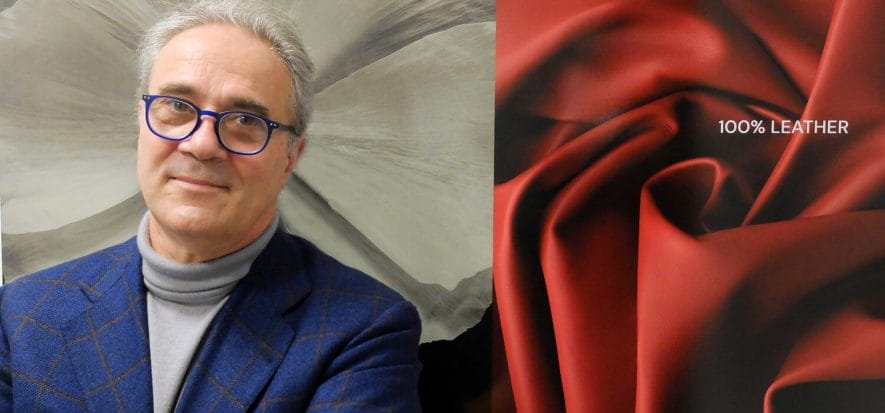The period was “very differentiated, based on the leather segment”. Which is “fairly logical”, given the daily criticalities that are present every day and that, in 2020, caused overall revenue to drop by 26% of its value. Then there is the need to continue improving on its sustainability excellency. Finding new ways to communicate to that the knowledge and awareness of those that, in the end “make the market go-round”: consumers. And much more. Three months after being nominated, on December 3rd, 2020, Fabrizio Nuti (Nuti Ivo Group), president of UNIC – Italian Tanneries, gives in this interview his view on the challenges that the Italian leather segment is facing.
Italian leather’s present time
What can be said about the start of 2021?
November and December of 2020 showed signs of recovery. But in January and February we noticed another slowdown. What we can say is that the situation is comprised by ups and downs, with many differences based on the reference segment to which tanners sell their product.
Who is struggling the most?
The segments most tied to tourists’ fluxes and those that make their mark when people are socializing. So, footwear, leather goods and fashion as a whole, which is, after tourism and restaurant business, the one most hit by the pandemic. Leather goods are slightly improving their condition thanks to the push of luxury brands.
Doesn’t the online channel help?
Of course, but it has its limits. The goods can’t go beyond a certain positioning. Some luxury accessories, to be chosen and bought, require a live experience, an emotional attachment. Something that can’t be substituted by a click.
Upholstery and automotive
The upholstery segment does better because after 1 year spent at home, the need of people became that of giving new life to their spaces. Automotive, on the other hand, showcases a steep increase, mainly due to the fact that the USA has put in place a series of incentives and the market bounced back. Of course, cars aren’t something that people change every six months and so it’s not easy to foresee what will happen in the upcoming periods. Also, because more and more electric vehicles are being designed as of lately.
These are cars that often don’t use leather interiors…
Yes. It’s still not clear why manufacturers associate electric vehicles to synthetic materials instead of leather.
The challenges of the Italian leather segment
A contradiction that doesn’t often happen within the automotive segment: how can they be won over?
That’s the grand challenge that we face. Our roles, as tanners, is useful for the planet. We collect a waste product of the food industry which, among other things, will increase in the next decades due to the constant increase o the global population, whether we like it or not, as meat consumption will go up. We give new life and value via techniques that don’t change the natural composition of the material. The tanning agents that we use, as of today, are almost exclusively renewable and biological. Including chrome, which is demonized for reasons that are difficult to understand.
And yet, “green marketing” continues to shift culpability onto leather…
We don’t do marketing, but real and tangible sustainability. We have been doing it for at least 60 years. Those that want to make others renounce leather are laying the foundations for two real types of damages. The first: leather, as a waste byproduct, would need to be “managed” or sent to landfills, but it’s hard to imagine that, also given their volume? Second: what are all products currently made of leather going to be made of? Cacti leaves or mushrooms? The vast majority of these accessories will end up being made of synthetic materials, and as we now those types of matters are anything but biodegradable.
And here we go back to the challenge we mentioned before: what can we do?
We need to promote our excellence, which isn’t just made of words for consumers to hear. We must make them understand that leather, especially Italian leather, as it is the best material that one can pick for its purchases because it contributes to cleaning up the planet. Italian tanners have all this substance, but we must become better at summarizing, in just a few words, what we showcase in the 60 pages of UNIC’s Sustainability Report. We must make leather a part of them, so that they even stop posing certain questions to themselves. The word must be enough. It’s a delicate action to take, but it’s one that must be taken. Up until now, with merit, we have been very focused on our companies. We have reached extremely high levels of quality. We strengthened our production quota at a global level, while some countries have reduced it. And we did so while continuing to manufacture in Italy. Yet, we haven’t spent enough time telling the world about our excellence. Now it’s the time to do so.
A strong message
What is the Italian leather segment asking to the new government led by Mario Draghi?
Beside from any necessary support, it would be enough to get a strong message.
Which one?
Mr. Draghi himself said that, as of right now, the government should focus on helping virtuous, excellent, and sustainable companies, and that giving monetary support to everybody with no selection is of no use. That’s it, Italy’s tanning segment is made of such companies. Businesses that are an example of artisanal savoir fare, that are innovative, attract foreign investments and don’t offshore production. Simply saying that tanneries are an example to follow, in this regard, would be a very significant endorsement for the segment.
Read also:
- The priorities of Italian leather: Interview with Fabrizio Nuti (UNIC)
- Sustainability Report 2020, leather enters the European Green Deal











